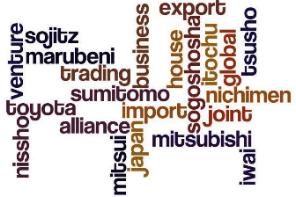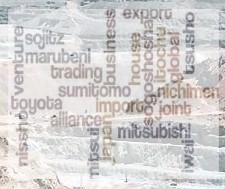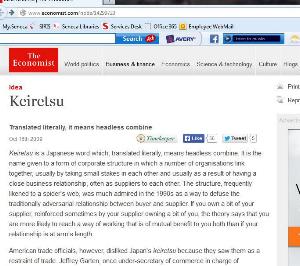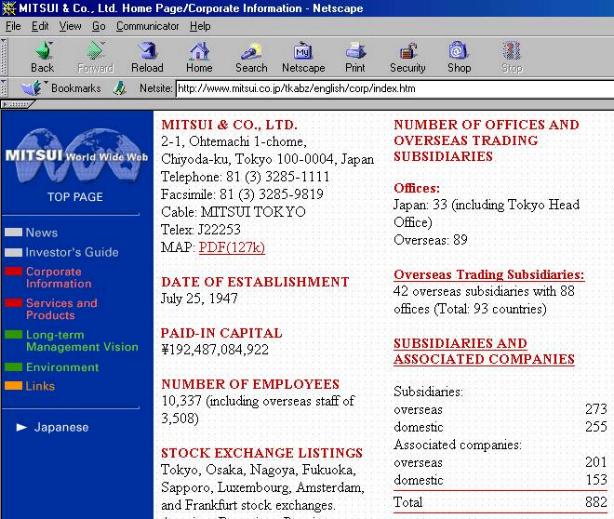SOGOSHOSHA
Japanese Trading Companies
and
KEIRETSU
interlinked corporate ownership

|
SOGOSHOSHA Japanese Trading Companies and KEIRETSU interlinked corporate ownership |
 |
changes were last made to this web page 2014 July 29
.
 |
Sogoshosha - Japanese Trading
Houses
www.economist.com/node/21554552 "While much of Japan is stagnant [2012] , the likes of Mitsubishi and Mitsui have become prime movers in the world's natural-resources boom." Since the Fukushima nuclear disaster Japan's sogoshosha have been busy developing opportunities to import more natural gas into Japan and they are developing joint ventures and alliances around the world where natural gas and shale gas are located |
 |
Sogoshosha -
Japanese Trading Houses
many Canadian mining companies
have relations with Japanese sogoshosha such as Mitsibishi, Mitsui, Marubeni
and Sumitomo
|
 |
April 2013
Joint Venture for LNG Liquefied natural gas project in B.C. Shell Canada Energy (Shell), PetroChina Corporation, Korea Gas Corporation (KOGAS) and Mitsubishi Corporation Dec 2012
2011
|
 |
"Keiretsu ... the name given
to a form of corporate structure in which a number of organisations link
together, usually by taking small stakes in each other and usually as a
result of having a close business relationship, often as suppliers to each
other. The structure, frequently likened to a spider's web, was much admired
in the 1990s as a way to defuse the traditionally adversarial relationship
between buyer and supplier. If you own a bit of your supplier, reinforced
sometimes by your supplier owning a bit of you, the theory says that you
are more likely to reach a way of working that is of mutual benefit to
you both"
The Economist magazine online
|
.

Chapter 17 Page 608 Export
Sogoshosha
|
"According to the Japan Fair Trade Commission (JFTC), almost 20% of Japan's capital was held by six major corporate groupings (Mitsui, Mitsubishi, Sumitomo, Fuyo, Sanwa, and Dai-Ichi Kangyo [DKB]) and their subsidiaries in Japan" http://pubs.acs.org/hotartcl/chemtech/97/jun/keir.html Cross-shareholding ratios of major keiretsu
|
|||||||||||||||||||||||||||||||||||||||||||
| Export
Trading Companies Keiretsu
|
"The keiretsu system
is a driving force behind Japan's industrial success"
Herbig Prof. Herbig explains
Prof. Herbig suggest Keiretsu
are relevant not just in Japan
Description of Keiretsu was
found on the site of Professor Paul Herbig www.tristate.edu/faculty/Herbig.html
|
| Export
Trading Companies Sogoshosha |
"Sogo shosha were first
established in the late nineteenth century"
Prof. Herbig explains
|
| The
Sogoshosha an example Mitsui - formerly incorporated just after WWII but in fact a company more than 300 years old Mitsui is the oldest |
 |
| Mitsubishi is the biggest | 
http://www.mitsubishi.or.jp/e/h/his.html - history of the origins of the company |
|
|
CONTACT I MAIN PAGE I NEWS GALLERY I E-BIZ SHORTCUTS I INT'L BIZ SHORTCUTS I MKTG?BUSINESS SHORTCUTS I TEACHING SCHEDULE |
| . | |
|
MISTAKES
ITEXTS
USED I
IMAGES
I RANK
IDISCLAIMER
I STUDENT
CONTRIBUTORS I FORMER
STUDENTS I PUBLICATIONS
I TIPS
I |
|
| . |